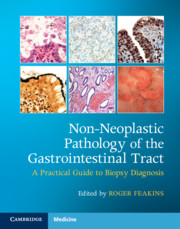Book contents
- Non-Neoplastic Pathology of the Gastrointestinal Tract
- Non-Neoplastic Pathology of the Gastrointestinal Tract
- Copyright page
- Dedication
- Contents
- Preface
- Acknowledgements
- Contributors
- Chapter 1 The Value of Gastrointestinal Biopsy
- Chapter 2 Gastrointestinal Involvement by Systemic Disease
- Chapter 3 Radiation and the Gastrointestinal Tract
- Chapter 4 Transplantation, Immunodeficiency, and Immunosuppression
- Chapter 5 Drug-Induced Gastrointestinal Disease
- Chapter 6 Gastrointestinal Ischemia and Vascular Disorders
- Chapter 7 Paediatric Conditions
- Chapter 8 Gastrointestinal Dysplasia
- Chapter 9 Normal Oesophageal, Gastric and Duodenal Mucosa
- Chapter 10 Histology of Gastroesophageal Reflux Disease and Barrett’s Oesophagus
- Chapter 11 Infections of the Oesophagus and Rare Forms of Oesophagitis
- Chapter 12 Assessment of Gastric Biopsies
- Chapter 13 Types of Gastritis
- Chapter 14 Duodenitis
- Chapter 15 Coeliac Disease
- Chapter 16 Inflammatory Bowel Disease and the Upper Gastrointestinal Tract
- Chapter 17 Normal Lower Gastrointestinal Mucosa
- Chapter 18 Infectious Disorders of the Lower Gastrointestinal Tract
- Chapter 19 Jejunitis and Ileitis
- Chapter 20 Microscopic Colitis
- Chapter 21 Inflammatory Bowel Disease Diagnosis
- Chapter 22 Mimics of Inflammatory Bowel Disease
- Chapter 23 Complications of Inflammatory Bowel Disease
- Chapter 24 Approach to Reporting Inflammatory Bowel Disease Biopsies
- Chapter 25 Ileal Pouch Anal Anastomosis
- Chapter 26 Diverticular Disease, Mucosal Prolapse, and Related Conditions
- Chapter 27 Non-Neoplastic Diseases of the Anal Canal
- Index
- References
Chapter 11 - Infections of the Oesophagus and Rare Forms of Oesophagitis
Published online by Cambridge University Press: 06 June 2020
- Non-Neoplastic Pathology of the Gastrointestinal Tract
- Non-Neoplastic Pathology of the Gastrointestinal Tract
- Copyright page
- Dedication
- Contents
- Preface
- Acknowledgements
- Contributors
- Chapter 1 The Value of Gastrointestinal Biopsy
- Chapter 2 Gastrointestinal Involvement by Systemic Disease
- Chapter 3 Radiation and the Gastrointestinal Tract
- Chapter 4 Transplantation, Immunodeficiency, and Immunosuppression
- Chapter 5 Drug-Induced Gastrointestinal Disease
- Chapter 6 Gastrointestinal Ischemia and Vascular Disorders
- Chapter 7 Paediatric Conditions
- Chapter 8 Gastrointestinal Dysplasia
- Chapter 9 Normal Oesophageal, Gastric and Duodenal Mucosa
- Chapter 10 Histology of Gastroesophageal Reflux Disease and Barrett’s Oesophagus
- Chapter 11 Infections of the Oesophagus and Rare Forms of Oesophagitis
- Chapter 12 Assessment of Gastric Biopsies
- Chapter 13 Types of Gastritis
- Chapter 14 Duodenitis
- Chapter 15 Coeliac Disease
- Chapter 16 Inflammatory Bowel Disease and the Upper Gastrointestinal Tract
- Chapter 17 Normal Lower Gastrointestinal Mucosa
- Chapter 18 Infectious Disorders of the Lower Gastrointestinal Tract
- Chapter 19 Jejunitis and Ileitis
- Chapter 20 Microscopic Colitis
- Chapter 21 Inflammatory Bowel Disease Diagnosis
- Chapter 22 Mimics of Inflammatory Bowel Disease
- Chapter 23 Complications of Inflammatory Bowel Disease
- Chapter 24 Approach to Reporting Inflammatory Bowel Disease Biopsies
- Chapter 25 Ileal Pouch Anal Anastomosis
- Chapter 26 Diverticular Disease, Mucosal Prolapse, and Related Conditions
- Chapter 27 Non-Neoplastic Diseases of the Anal Canal
- Index
- References
Summary
Gastro-oesophageal reflux disease (GORD) is a condition that develops as a result of retrograde flow (reflux) of gastro-duodenal contents into the oesophagus, with or without mucosal tissue damage. The main symptoms include heartburn without a specific frequency or duration. Histological mucosal changes include mild basal cell hyperplasia, scattered intraepithelial eosinophils, dilated intracellular spaces, and lamina propria papillae reaching the upper one-third of the squamous epithelium. Other histological findings that can be present in the setting of GORD are balloon cells, keratinocyte vacuolization, intraepithelial lymphocytosis, vascular lakes, and parakeratosis. Ulceration can also occur if GORD is severe. Barrett’s oesophagus (BO) is an acquired condition defined by endoscopically visible metaplastic columnar epithelium more than 1 cm above the gastro-oesophageal junction (GOJ) with biopsy confirmation of columnar metaplasia. Presence or absence of intestinal metaplasia (IM) should be documented as it harbours an increased risk of progression to oesophageal adenocarcinoma (OAC). The risk of progression of BO to OAC increases if there is dysplasia in addition to columnar metaplasia. Endoscopic examination in conjunction with histopathological evaluation and documentation of presence or absence of dysplasia is the current recommended method of surveillance.
Keywords
- Type
- Chapter
- Information
- Non-Neoplastic Pathology of the Gastrointestinal TractA Practical Guide to Biopsy Diagnosis, pp. 169 - 178Publisher: Cambridge University PressPrint publication year: 2020



